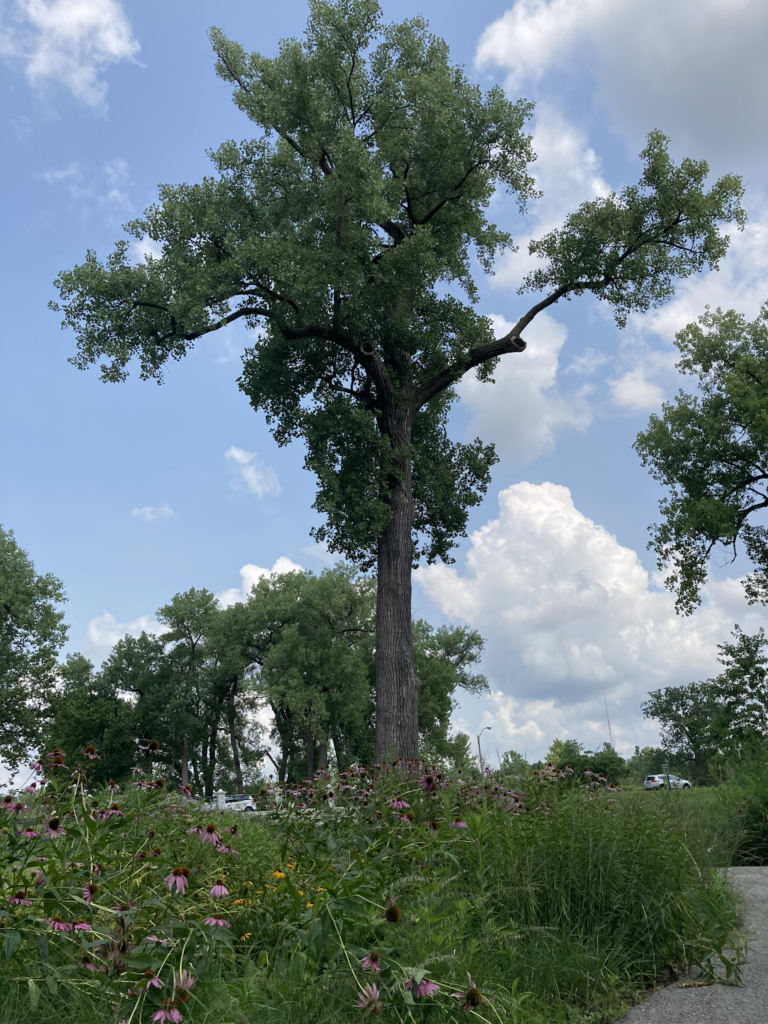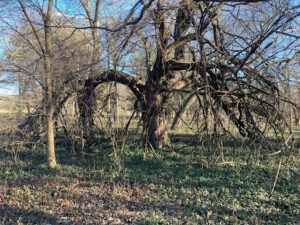By: Mark Halpin, Forestry Manager
The Eastern cottonwood, Populus deltoides, is a “bull in a China shop” of a tree. Commonly reaching 75 or more feet and with the potential to break into the hundreds, with a spread normally ¾ or so of the width, it isn’t exceptionally large except in trunk girth. What is exceptional is the speed with which it attains such lofty heights – young and vigorous trees can grow 10 feet or more in a year, although just as a Cheetah can only sprint 80 mph for a few seconds, this staggering speed is not sustained over a lifetime. A cottonwood can certainly reach relatively mature heights of 65-80 feet in 50 years or less, possibly as few as 20. Which means that a stray seedling can become a liability faster than perhaps any other species you’re likely to find popping up in your garden.
And pop up they will! The common name ‘cottonwood’ refers to the cotton-like tufts of airborne seeds that waft through the air in late spring and early summer, causing all manners of irritation. Notorious blockers of air conditioner filters and perhaps the only seed that you can unwittingly inhale large quantities of, they can travel for miles floating on air currents. They will germinate readily on moist soil and stand proud above the other plants in your gardens within weeks. As aggravating as this is, there is a tranquil magic to behold if you find yourself in a lazy storm of cottonwood seeds floating around on a warm day. It’s as if a cloud exploded and the debris is drifting down to earth, and as much trouble as they can cause as sources of weed seed and air conditioner trouble, they tend to disappear pretty quickly otherwise.
Cottonwoods form roots so easily that you can lop a branch off of one, stick it into the ground, and if moisture is adequate it will take up residence and begin that vigorous youthful growth. This trait, shared with its relatives in the Willow family, makes it one of the easiest trees to transplant, seeing as it doesn’t even require a root system.
Like the black willow, this is a tree best left to natural areas, but in natural areas it can perform the work of 10 lesser trees in terms of the water it can absorb and clean, the air pollution it can absorb, and the cooling effect it can have on the landscape, all in just a few decades. It lives fast, dies young and leaves a broken corpse strewn across the landscape but when it’s alive, it’s a workhorse. For bank stabilization, drying out swampy areas or just getting something growing in wet, problematic areas, it has no equal. A towering cottonwood, “the pioneer of the prairie”, never fails to amaze onlookers. I can imagine the early human pioneers of the prairies crossing hot, sun-drenched miles and glimpsing one in the distance, knowing it means water and sweet relief is near. The dappled shade of these giants, with the mellow song of their rustling leaves, must have seemed heavenly. With so many huge shade trees in our region we get to be picky, but in the prairies and deserts anything that grows over 20 feet tall is appreciated. In such places the cottonwood is king.
A side note: Many modern rain gardens require their filters to be replaced every 15-20 years, requiring all of the plants in them to be removed at the same time. Baldcypress is the popular choice for most of these if trees are being used. If the goal is an exceptionally thirsty tree that is going to be killed in less than twenty years…why pick one that can live for 600? Why not use a cottonwood? It will drink up more water and it will be removed before it becomes a liability. Landscape architects, please take note!




